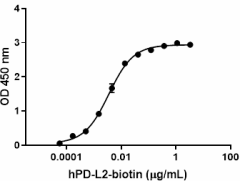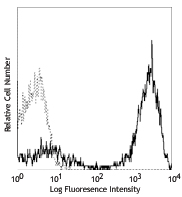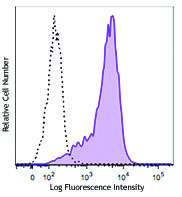- Regulatory Status
- RUO
- Other Names
- CD273, Programmed cell death 1 ligand 2 (PD-L2), B7 dendritic cell molecule, B7-DC, Butyrophilin B7-DC, PDCD1 Ligand 2, PDCD1L2, PDL2
- Ave. Rating
- Submit a Review
- Product Citations
- publications

-

When human PD-1-Fc Chimera is immobilized at 1.0 µg/mL, biotinylated human PD-L2-Fc Chimera binds with an EC50 of 3 - 12 ng/mL. HRP Avidin (Cat. No. 405103) was used to detect the binding. -

Stability testing for Biotinylated Recombinant Human PD-L2-Fc Chimera. Biotinylated Recombinant Human PD-L2-Fc Chimera was aliquoted in PBS, pH 7.2, 5% glycerol at 0.2 mg/mL. One aliquot was frozen and thawed four times (4x Freeze/Thaw), and compared to a control kept at 4°C (Control). The samples were tested in a binding assay with human PD-1-Fc Chimera.
PD-L2 is a type I transmembrane protein of 273 amino acids, and it is a member of the B7 family. Human PD-L2 has 70% amino acid identity to its mouse orthologue. PD-L2 is the second ligand for PD-1, and its binding to PD-1 leads to the inhibition of T cell receptor–mediated lymphocyte proliferation and cytokine secretion. PD-L2/PD-1 interaction suppresses immune responses against autoantigens and tumors and plays an important role in the maintenance of peripheral immune tolerance. Antibody blocking of PD-L2 on dendritic cells results in enhanced T cell proliferation and cytokine production. Interaction of PD-1 by PD-L1-Ig or PD-L2-Ig fusion protein has an inhibitory effect on proliferation and cytokine production during anti-CD3-mediated stimulation. PD-L2 is expressed in biopsies from human asthmatics and lungs of aeroallergen-treated mice and its expression correlates with the asthma severity. In vivo blockade of PD-L2 reduces the severity of allergen-driven airway hyperresponsiveness (AHR). Blockage of PD-L2 induces the IL-12 production by DC; IL-12 may limit the severity of allergen-induced AHR antagonizing IL-13. In addition, blockade of PD-1 does not have an effect on AHR; therefore, PD-L2 controls asthma severity in a PD-1 independent manner. PD-L2 binds to a second receptor, RGMb (repulsive guidance molecule b) which is expressed in lung interstitial macrophages and alveolar epithelial cells and is a co-receptor for bone morphogenetic proteins BMP2/4. Blockade of the RGMb/PD-L2 interaction significantly impaired the development of respiratory tolerance since the initial T cell expansion is inhibited.
Product DetailsProduct Details
- Source
- Human PD-L2, amino acids Leu20-Pro219 (Accession # Q9BQ51) with C terminal human IgG1 Fc and 6His tag was expressed in 293E cells.
- Molecular Mass
- The unlabeled 445 amino acid recombinant protein has a predicted molecular mass of approximately 50.2 kD. The DTT-reduced and non-reduced protein migrate at approximately 70 kD and 140 kD respectively by SDS-PAGE. The predicted N-terminal amino acid is Leu.
- Purity
- > 95%, as determined by Coomassie stained SDS-PAGE.
- Formulation
- 0.22 µm filtered protein solution is in PBS, pH 7.2, 5% glycerol.
- Endotoxin Level
- Less than 0.01 ng per µg cytokine as determined by the LAL method.
- Concentration
- 10 and 25 µg sizes are bottled at 200 µg/mL. 100 µg size and larger sizes are lot-specific and bottled at the concentration indicated on the vial. To obtain lot-specific concentration and expiration, please enter the lot number in our Certificate of Analysis online tool.
- Storage & Handling
- Unopened vial can be stored between 2°C and 8°C for one month, at -20°C for six months, or at -70°C for one year. For maximum results, quick spin vial prior to opening. Stock solutions should be prepared at no less than 50-100 µg/mL in sterile buffer (PBS, HPBS, DPBS, and EBSS) containing carrier protein such as 0.2 - 1% BSA or HSA and stored in working aliquots at -20°C to -70°C. Avoid repeated freeze/thaw cycles.
- Activity
- When human PD-1-Fc Chimera is immobilized at 1.0 µg/mL, biotinylated human PD-L2-Fc Chimera binds with an EC50 of 3 - 12 ng/mL. HRP Avidin (Cat. No. 405103) was used to detect the binding.
- Application
-
Bioassay
- Application Notes
-
BioLegend carrier-free recombinant proteins provided in liquid format are shipped on blue ice. Our comparison testing data indicates that when handled and stored as recommended, the liquid format has equal or better stability and shelf-life compared to commercially available lyophilized proteins after reconstitution. Our liquid proteins are verified in-house to maintain activity after shipping on blue ice and are backed by our 100% satisfaction guarantee. If you have any concerns, contact us at tech@biolegend.com.
Antigen Details
- Structure
- Disulfide-linked homodimer, biotinylated via amines.
- Function
- Inhibits T cell mediated proliferation and cytokine production by CD4+ T cells. Regulates T cell responses. PD-L2 expression is upregulated on antigen-presenting cells by IFN-γ.
- Interaction
- T cell
- Ligand/Receptor
- PD-1
- Bioactivity
- Measured by its ability to bind human PD-1.
- Biology Area
- Costimulatory Molecules, Immunology
- Molecular Family
- CD Molecules, Immune Checkpoint Receptors, Soluble Receptors
- Antigen References
-
- Latchman Y, et al. 2001. Nat. Immunol. 2:261-68.
- Brown JA, et al. 2003. J. Immunol. 170:1257-266.
- Youngnak P, et al. 2003. Biochem. Biophys. Res. Commun. 307:672-77.
- Singh AK, et al. 2011. Allergy. 66:155-62.
- Lewkowich IP, et al. 2013. Mucosal Immunol. 10.1038/mi.2012.111.
- Xiao Y, et al. 2014. J. Exp. Med. 10.1084/jem.20130790.
- Bardhan K, et al. 2016. Front Immunol. 7:550.
- Gene ID
- 80380 View all products for this Gene ID
- UniProt
- View information about PD-L2 on UniProt.org

 Login / Register
Login / Register 

















Follow Us